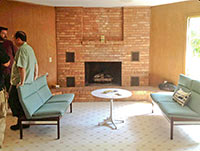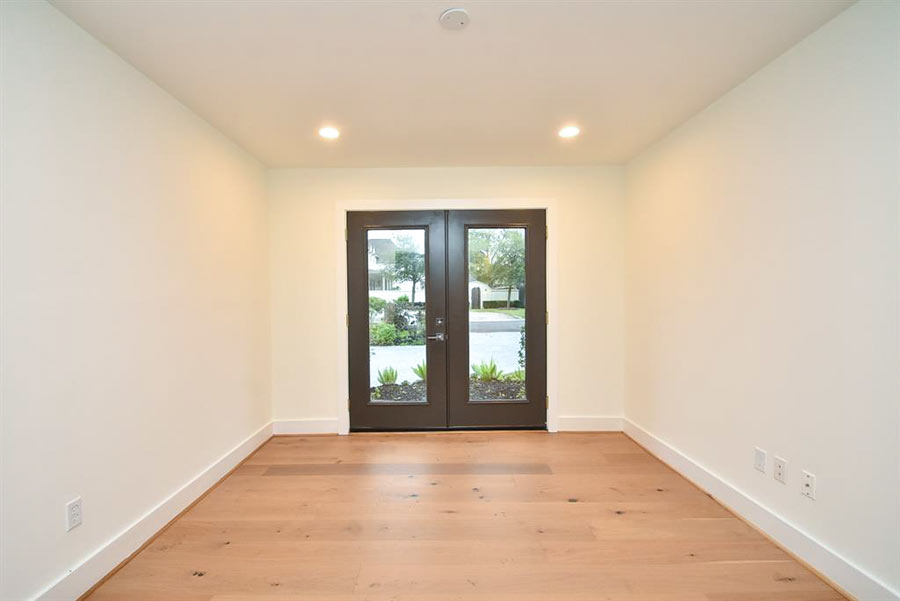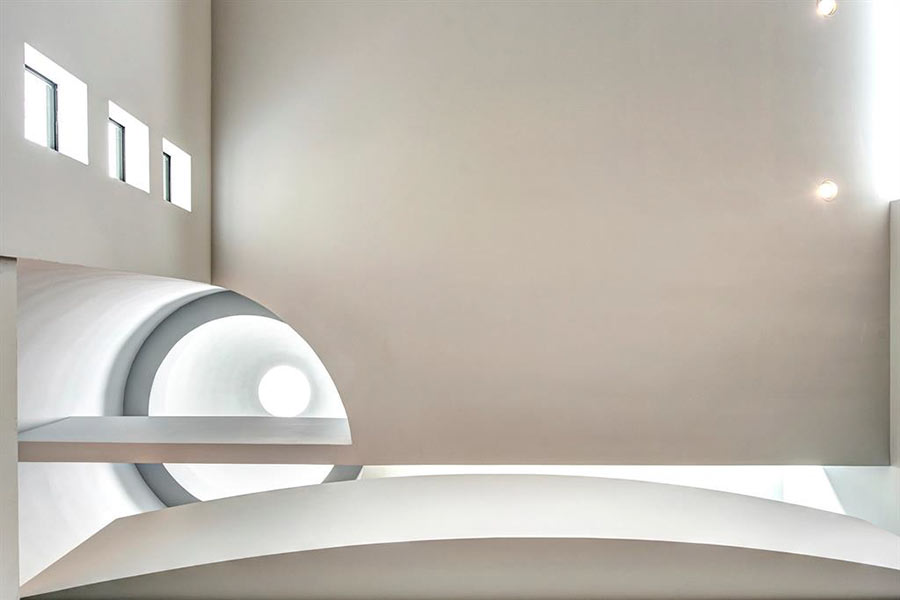A MEADOWCREEK VILLAGE HELP-YOU-SELL  “SELLER WILL DO NO REPAIRS,” shouts the listing. But . . . um, visitors to this past Sunday’s open house did bring their own period furniture to dress up a brick flat-roofed Modern 4-bedroom in Meadowcreek Village celebrating its 49th birthday — as a foreclosure. That was for Houston Mod’s hastily announced Mod of the Month event. The instant living room arrangement from Heights vintage shop The Mod Pod is gone now, but the 2,558-sq.-ft. vinyl-over-terrazzo home at 2042 Forest Oaks Dr. is still on the market at $99,900. [HAIF; listing] Photo: Mod Pod/Karen Moyers
“SELLER WILL DO NO REPAIRS,” shouts the listing. But . . . um, visitors to this past Sunday’s open house did bring their own period furniture to dress up a brick flat-roofed Modern 4-bedroom in Meadowcreek Village celebrating its 49th birthday — as a foreclosure. That was for Houston Mod’s hastily announced Mod of the Month event. The instant living room arrangement from Heights vintage shop The Mod Pod is gone now, but the 2,558-sq.-ft. vinyl-over-terrazzo home at 2042 Forest Oaks Dr. is still on the market at $99,900. [HAIF; listing] Photo: Mod Pod/Karen Moyers





Great buy for $99k.
Will need about $50-100K more in fixing and repairs, but still good price.
Lots of potential with this house. Surprised someone hasn’t grabbed it yet. The lot is very private and has many mature trees.
Probably wouldn’t pass inspection, so hard to get financing for. A problem with a lot of mods, unfortunately.
Marmer, care to elaborate? I’m curious as to just what sort of code problems make these houses end up as teardowns instead of restos.
It’s in a flood zone. I was interested in that beautifully restored mod on Shelterwood, but it had flooded during Allison.
From what I’ve heard from mod homeowners, it’s not so much code inspections as inspections required by lenders. Almost always mods require new plumbing, AC, roofs and electrical wiring in some combination. With many houses, the seller has to pay for those things but they make their money back when the house sells. If the seller isn’t willing to make the repairs then a bank might not be willing to lend on a house that needs new wiring or new plumbing. If the buyer can pay cash, then it doesn’t matter. Mods often have the particular issues of roof integrity and window sealing; some I am particularly familiar with have interior brick or ceramic walls and/or wiring in the slab which make electrical updates really hard.
The only thing it has to get by on condition, besides the buyer, is obvious serious things with the appraiser. The appraiser won’t do a full on inspection, but in the case of this house will note water stains from leaks in the ceilings, and cracks in the wall from foundation problems. Those issues will mean no bank will lend on the house, so it will take an all cash buyer. That does not, especially in this case, relegate it to tear down status, but it does mean that if you don’t have cash, you are not going to be in a position to get this house.
What I described doesn’t make it a teardown, just harder to sell. What makes them a teardown, generally, and this is a big generalization, are combinations of small or inconvenient bathrooms and kitchens, small bedrooms with inadequate closets, major structural or water integrity issues, and extremely attractive locations.
As someone who grew up in one of these houses in Spring Valley, I can attest to their difficulty to maintain. My mom is lucky -she has no foundation problems, but the roof is another story. So much more expensive to fix than a traditional shingled roof and it never lasts as long. The most curious aspect of her house is her a/c unit in a closet inside the middle of the house, suspended over a 3′ pit to collect overflow water. Until I went to college, I had no clue that trickling water noise wasn’t a regular home feature. It seems to me you have to have a lot of love and patience to keep up with one of these – but ours has lasted a good 60 years now. That said, I’m sure that when she decides to sell, it will come down and something new and monsterous will go up in its’ place – that’s just the way of things.
Thank you all for your insight. It pays to know what you’re getting into with your fixer-upper purchase!
Don’t flat roofs fail home insurance inspections? I though you had to have a minimum grading on a roof to get homowner’s insurance approval. Or is it a building code thing?
Neither.
Whatever is right. Flat roof doesn’t really have any effect provided it’s in good shape. Unless the rules have changed recently. Most of the houses I’ve seen, admittedly, have had gently pitched roofs. Wiring and foundation are the big betes noires that most homeowners tell me about.
I also toured this house on Sunday and even though it is a great layout and the design is on point, it needs a lot of work. My estimation is about $130k-150k to get it back to great shape. So much needs to be done, house needs to be leveled, gutted, new roof, electrical and plumbing. This estimate is having contractors do the work. This will be a major undertaking. I just would have liked to see what this house looked like after it was just built and furnished. I imagine it looked amazing. It’s a great house…too bad it is in the condition that it is. Hopefully someone can restore it…. 150k + 100k put you. $250k invested. Wouldn’t mind tackling this but it’s a bit much.
The main issue I have with this house is that it is kind of in the middle of nowhere. And there was some kind of petro chemical burnoff when I was there on Sunday. It really could be a cool house, though.
I don’t see why any bank would have a problem with the loan if the property is being sold for lot value? These older homes typically are. The bakn appraisal should effectively reflect that.
In my opinion, anyone trying to remodel an old house that is in the floodplain is going to have a hard time. From the City of Houston Code of Ordinances, Chapter 19 FAQ:
Can I obtain a permit to make improvements to my existing home in the floodway?
• Yes. Improvements which exceed 50% of the market value of the structure or expand the existing
footprint require compliance with the performance standards for construction in the floodway.
• Improvements to upgrade and/or maintain properties in the floodway are not prohibited. Permits for
interior and exterior improvements that do not increase the building footprint are reviewed and
issued in a routine manner. Examples include kitchen remodeling, bathroom remodeling, and other
similar interior maintenance needs.
• No change has been made to a home owner’s ability to obtain a permit for such improvements.
Can I obtain a permit to add another room to my existing home in the floodway?
• Yes. If the new room is on the second floor of your existing home and the construction is not a
“substantial improvement†(exceeds 50% market value) a development permit may be issued.
• If the new room expands the footprint of the home or results in a “substantial improvementâ€, the
structure must comply with the performance standards for construction in a floodway.
What is a “substantial improvement�
• Any improvement that exceeds 50% of the market value of the structure prior to the event or
improvement in question is defined as a “substantial improvement.â€
• If an applicant requests a permit for construction that results in a substantial improvement to a
structure in the floodplain or floodway, then the entire structure must be brought into compliance
with regulations for new construction.
As much as I like the $100k price tag, I’m afraid the amount of money required to make this house shine would price it out of the neighborhood. I went to look at it yesterday, and it needs it all. Foundation work, all windows/doors, mechanicals updated, floors, paint, ant infestation, landscaping, etc. I am not very familiar with the area, but having driven around it, I’m not sure you could make money from it, nor would I choose to live there. Although it would be a very cool project…
Karen,
This house is not on a floodway, its in the 500 (a half in a 100) year floodplain. That ordinance does not apply. This house is no different than renovating in Meyerland, most of which is in a 100 year floodplain. Harder, yes, but not nearly a buyout from FEMA candidate.